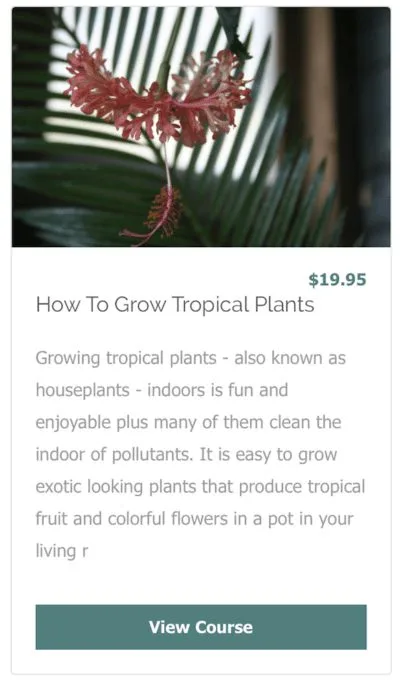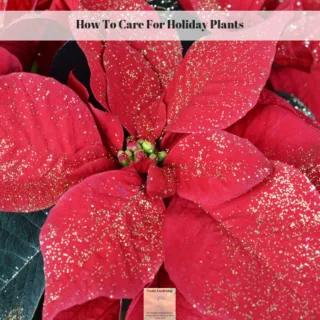When you grow tropical plants in cold climates you have to decide if you want to overwinter them or let them die and start over again come spring.
Many tropical plants bloom the first year when grown from seed while others have bulbs or tubers that are easy to overwinter or buy each spring.
Tropical plants, known for their exotic and jungle-like appearance make perfect specimens to grow for a quick privacy fence without the expense, work or unnatural appearance that a true fence would have.
They are also excellent choices for a quick cover up to make a garden look established.
Finally they do make great houseplants - and when you consider what a houseplant is, you are sure to realize it is a tropical plant.

The parrot impatiens or Congo cockatoo flower, seen above, is one example of a tropical plant you might consider an annual and start from seed every spring.
However, Impatiens niamniamensis is actually a tropical plant that hails from Africa.
It can reach a height of four feet tall, however the typical height is two to three feet tall.
It is a shade plant that actually prefers low light, so it is ideal for those less than sunny areas in your home.
Not to mention it may even flower and those tri-colored blooms are even more impressive in person than they are in a picture.

Ricinus communis or Castor Beans as they are commonly called are easy to start from seed each spring.
By fall you will have a full sized plant that will have flowered and be producing seeds for you to save for next year’s garden.
The typical castor bean plant grows quite tall making it an excellent specimen for the back of a border, be aware however that there are miniature varieties available.
The seeds are toxic so keep the both the plant and the seeds out of reach of children and pets.
This plant prefers full sun but can tolerate some shade.
While I have grown this indoors, it is one that really is better to be started from seed each spring.


Cannas are easy enough to grow indoors provided they get plenty of light, but honestly it is easier to dig the rhizomes once the foliage dies back from frost.
Store the canna rhizomes in a cool, dark place such as an unheated garage or basement.
Once spring rolls around again, just replant the rhizomes.
For an earlier start Cannas can be started in pots around March then transplanted into the garden once warm weather sets in.
Cannas can be grown in full sun, but depending on the variety you may find that there is less leaf burn if they are grown in light shade.

Brugmansia are easily over wintered in an unheated garage or basement.
They can also be brought indoors where they will continue to grow.
While you can start Brugmansia from seed, it is easier to just keep the plant alive or take cuttings and root them over the winter if you don't have room for the entire plant.
Brugmansia are toxic so this is a plant to keep away from children and pets.
When over wintering indoors you may want to keep the blooms cut off to prevent any allergic reactions to the incredibly strong perfume these plants produce after dark.
Outdoors Brugmansia plants prefer at least six hours a day of sun.

Colocasias are an easy bulb to over winter.
You can continue to grow them indoors or dig them and store them along with your other bulbs.
Personally I'd just dig and store the colocasia bulbs because there doesn't seem to be a benefit to growing them indoors.
Of course some people may want those large leaves as part of their home decor and if that is the case, go right ahead and grow them through the winter months.
These plants prefer slightly damp soil and full sun to part shade.
The Calocasia with dark leaves, such as ‘Blackie,’ seem to loose their color in the shade.

Ipomea batatas or sweet potato vines can be dug and stored or you may continue to grow them indoors.
These plants are best used as a ground cover instead of a typical climbing vine.
Another popular use for them is trailing over the side of containers.
The key to over wintering any type of bulb is to either dig it and store it in a cool, dark place or leave it in the pot and give a small amount of water every four to six weeks to keep the tuber moist.

Caladiums and Tuberous Begonias are both bulbs that can either be dug and stored or kept growing.
If they do die back on you it is likely that they have just gone dormant.
Once spring rolls back around bring them out and begin watering again.
Caladiums prefer shade.
Tuberous Begonias prefer a bright, shaded spot.
Both plants like to be kept moist but not wet.

The last plant that is easy enough to grow from seed is Clitoria.
Available in single and double forms with either white or blue flowers this vigorous vine can quickly cover a trellis.
Grown indoors, it will flower in the winter as long as it gets enough light.
The real advantage to overwintering this plant is that even if it does not flower indoors, it will burst into blooms as soon as it is back outdoors.
If you decide to over winter your plants in the house and they go dormant, either move them to a cooler area or be sure to give them a small amount of water each month so that the bulbs or rhizomes do not dry up and die.
Flowering Tropical Plants
How To Grow Tacca To Be A Successful Bloomer
The black flowers intrigued me, but the bat plant comes in many colors - brown, white and even green! Learn how to grow tacca from seed to bloom!
Amorphophallus Titanium: Life Cycle And Facts About The Corpse Flower
Learn about the life cycle of the Amorphophallus titanium as well as how to propagate it and some fun facts about this unique corpse flower.
Introducing Brugmansia: A Superior, Fragrant, Nocturnal Plant
Brugmansia trees are highly fragrant, night blooming plants with trumpet shaped flowers. Learn how to care for your brugmansia.
How To Care For Holiday Plants
Have you ever wondered how to care for holiday plants such as the Poinsettia or the Christmas Cactus? If so, then check out this holiday plant care guide
Zantedeschia aethiopica Green Goddess
Learn how easy it is to grow Zantedeschia althiopica Green Goddess from seed by using the damp paper towel method plus seed to bloom time.
How To Grow Heliconia
Learn how to grow Heliconia. Proper plant care is important to keeping your Heliconia healthy and thriving.
Plumeria: The Lei Flower Is A Fragrant, Easy To Grow Houseplant
Learn how to care for your Plumeria in ground and in containers. Because of the winter dormancy period it is ideal for summer containers.
Growing Tropical Plants
The key to successfully growing tropical plants is learning about them. Growing tropical plants is easy once you know their basic needs.
7 Sure Fire, Proven Steps For Successful Orchid Care
Successful orchid care is pretty easy once you understand the seven basic steps the plant needs to thrive in your home environment.
How To Grow Enormous Tropical Bulbs In Containers
Learn how to successfully grow tropical bulbs in containers. Regardless of where you live, there are reasons to grow in containers.
Easy Exotic Houseplants: Tropicals That Thrive Indoors in Containers
Tropical plants are the most beautiful, easy to grow indoor houseplants. Start growing exotic houseplants today that fruit and flower!
Coral Vine (Antigonon leptopus): A Beautiful Yet Invasive Climbing Vine
Explore the allure and challenges of Antigonon leptopus, a captivating climbing vine, and its impact on local ecosystems.
Suggested Reading: Two Great Books On Tropical Ornamentals
Learn about two books on tropical ornamentals. Breeding Ornamental Plants and Tropical Ornamentals are a must read for those who love plants.
How To Grow Beautiful, Delicate Tibouchina
Tibouchina are beautiful but delicate plants with gorgeous purple flowers and a velvet like foliage. They can be bushes or vines.
How To Grow Mallows
Learn how to grow mallows, a Malvaceae family which includes some of the most popular plants for the home garden, Hibiscus.
Ophrys
Ophrys are a rare group of terrestrial Orchids that grow in the wild and look like insects, especially bees, hence their common name.
Flowering Trees For Fragrance And Beauty
Flowering trees add beauty and fragrance to the garden. There are ones for tropical climates, cold climates and even indoor gardens.
Expert Advice On How To Grow Beautiful Allamandas
Allamandas come in a range of colors, are easy to grow and do well in containers. They also overwinter well indoors in cold climates.
Expert Advice On How To Grow Oleanders
Learn how to grow Oleanders as well as propagation methods. Learn about the toxicity of this plant as well.
Rafflesia Arnoldii
Rafflesia arnoldii produces the largest flower in the world yet this colorful, but strange plant is rare and grows on the rainforest floor.
Celebrate Halloween With Night Blooming Plants
A cool way to decorate and celebrate Halloween is with night blooming plants! Create a spooky garden that glows in the dark this year!
How To Grow Tropical Plants
Growing tropical plants - also known as houseplants - indoors is fun and enjoyable plus many of them clean the indoor of pollutants.
It is easy to grow exotic looking plants that produce tropical fruit and colorful flowers in a pot in your living room or office.
Many of these plants are easy to start from seed and I share with you five plants that I recommend for indoor growing.
I also share with you why growing your own tropical fruit saves money.
In this video you will learn:
How to bring tropical plants indoors at the end of summer
How to grow tropical plants indoors
How to protect and overwinter tropical plants outdoors in cold climates
How to propagate tropical plants
How to water tropcial plants
How to grow topical plants in a greenhouse























